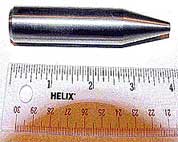 |
|
|
Environmental Effects: Depleted UraniumWhat is depleted uranium?Natural uranium is a mixture of two main isotopes – Uranium 238 and Uranium 235. Before it can be used in a nuclear power station this natural mix needs to be enriched so that it contains a higher proportion of U – 235. This ensures that the nuclear fuel can undergo fission and produce the heat needed to generate power. Depleted uranium is a by-product of this enrichment process and its physical properties make it ideal to be used as the raw material to manufacture armour piercing projectiles. As well as being very hard it, ignites and vaporises on impact – due to the conversion of kinetic energy to thermal energy. The resulting hot, expanding gas completes the task of blasting through armour. The DangersDepleted uranium remains radioactive for 4.5 billion years. The fine particles produced when the material vaporises can settle on the ground, is present in the air, and can enter water systems. Therefore depleted uranium could enter humans through the air or through food and water. When inhaled, the alpha and beta particles emitted can cause the mutation of cellular DNA and result in cancer. Where has DU been used?The US military has used depleted uranium munitions in Iraq, Afghanistan and in the former republic of Yugoslavia. Karen Parker works as a consultant lawyer for the United Nations, and claims that the use of DU “violates the existing law and custom of war”. When the issue was first raised in the United Nations in 1996, she introduced four rules - derived from an interpretation of humanitarian law regarding weapons.
She claims that the use of depleted uranium breaks all for of these rules.
|



 U.S. Dept of Defence
U.S. Dept of Defence National Gulf War Resource Centre
National Gulf War Resource Centre Uranium Medical Research Centre
Uranium Medical Research Centre BBC
BBC Legitimacy of war
Legitimacy of war
What's your opinion?
Average rating




Not yet rated